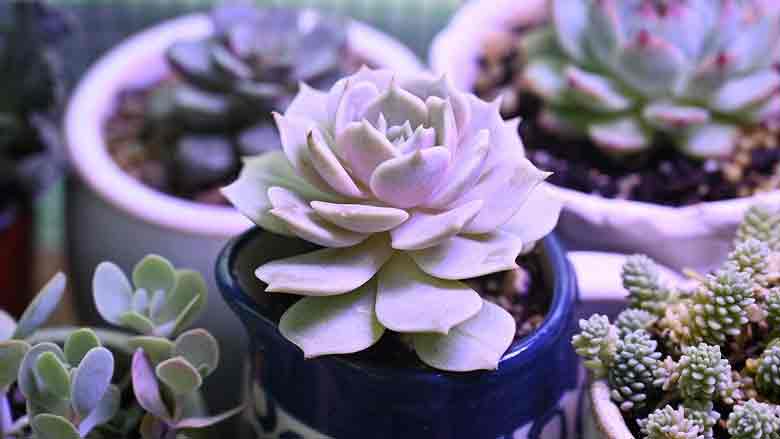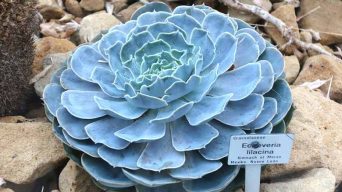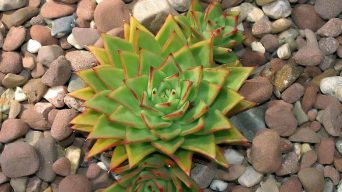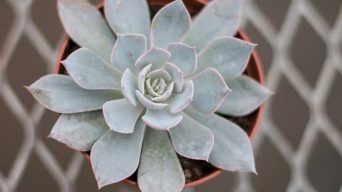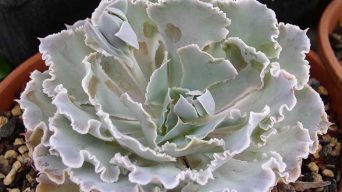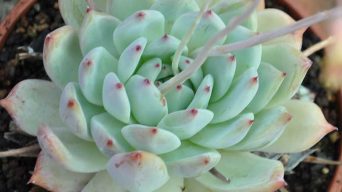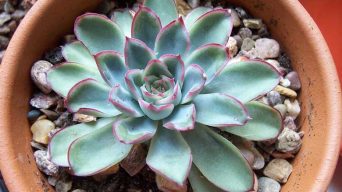Growing succulents is an exciting and creative hobby allowing you to cultivate small art pieces.
The Echeveria ‘Lola’ succulent plant is one of the most popular types of flowering succulents because it has gorgeous symmetrical rosettes with thick leaves on strong stems.
This succulent plant looks beautiful in pots on its own or together with other succulents.
Read on to learn how to take care of and propagate the Echeveria ‘Lola’ succulent plant in your home!
Overview
The Echeveria ‘Lola’ is a perennial succulent member of the Crassulaceae family from Mexico or Central America.
This succulent plant is a rosette-shaped echeveria species that is a cross between the Ghost Echeveria Succulent and Echeveria derenbergii.
Echeveria ‘Lola’ will reach a height of around 4-6 inches and 6 inches wide, with pale gray-blue leaves that have a blush of pinkish-violet.
The leaves will acquire a pinkish tinge around the edges when exposed to higher light and colder temperatures.
Yellow or crimson pink bell-shaped flowers bloom on thin stems in the spring and early summer.
How To Care for Echeveria ‘Lola’
Taking care of Echeveria ‘Lola’ is pretty simple, but there are a few essential things to know about this gorgeous succulent.
Below you’ll find the most important information you need to know about caring for Echeveria ‘Lola’.
Sun Exposure & Light Requirements
Echeveria ‘Lola’ requires bright light, preferably direct morning or afternoon sunlight. Keep in mind that.
Echeveria plants are not able to survive intense heat and therefore need partial shade in summer. Plants that are actively growing require more light, however.
If unsure of the type of light required by an Echeveria plant or how long it can survive in direct sunlight, keep it at a location where it will be exposed to bright indirect sunlight during the morning and late afternoon.
When growing Echeveria indoors, place your plants near a west-facing or east-facing window that gets plenty of bright, indirect light.
During the summer, keep them in a shaded area when outdoors. Provide some shade, especially during the hottest hours of the day.
Watering Requirements
Echeveria ‘Lola’ is a succulent plant, and like all other succulents, it doesn’t need much water. You should only water the Echeveria plants once a week to allow the soil to dry out before watering deeply.
Excess water will cause the plant’s roots to rot and lead to its demise. You mustn’t overwater your plants and ensure they get enough drainage in their pot.
If left in a very wet environment, it might develop root rot (if wetness gets into the rosette and causes its leaves to turn yellow and fall off).
You should avoid getting water on the leaves as this will lead to fungal rot, which will cause the leaves to curl up and die.
Water the plant deeply (the soil should be wet all the way to the bottom of the pot).
Then leave them for an hour or two. This is important as it allows the water to soak into the soil, and then you can let the excess water drain from their pot.
The best time to do this is between 10 pm and 1 am as it will not be exposed to sunlight, which will minimize the risk of fungal rot.
In the summer months, you will need to water them more frequently, whereas in the winter months, reduce the watering frequency as they go dormant during this time.
Soil Requirements
Echeveria ‘Lola’ is a slow-growing, compact plant that does well in small pots with coarse standard cactus/ succulent potting soil and perlite (for drainage).
The soil for the seedlings and small plants will need to be of a finer quality.
For best results, use a standard cactus/succulent potting soil that contains coarse sand and perlite.
This mix encourages drainage and lasting moisture, which the Echeveria ‘Lola’ prefers.
Temperature and Humidity
Echeveria ‘Lola’ grows in tropical, desert-like weather with an average temperature of 18°C (about 64°F) during the day and 12°C (about 54°F) during the night.
The Lola echeveria can adapt to slightly higher temperatures in a dry environment or bright light. However, it is important not to let them exceed 23°C (about 73°F) during the day.
If you keep your Echeveria ‘Lola’ outside during summer or intend on growing it outdoors for the summer, make sure to acclimate the plant gradually.
Echeveria ‘Lola’ does need humidity, around 40% relative humidity. If the humidity stays too high for too long, you will find that it causes root rot.
Fertilizing
The Echeveria ‘Lola’ is a slow-growing plant that only needs fertilizer every 1-2 months in the growing season.
If you do not want to fertilize, that is fine too! Just do not fertilize more than twice in one growing season. Echeveria ‘Lola’ succulents are sensitive to over-fertilization, which can harm the plant.
If you are fertilizing Echeveria ‘Lola’ succulents, use a balanced liquid fertilizer diluted to half-strength.
Make sure not to allow the fertilizer to come in contact with the leaves. If this happens, wash it off immediately with water. Only fertilize the soil, not the leaves.
Potting and Repotting
The Echeveria ‘Lola’ succulent is a slow-grower by nature, so you should wait between one to two years after you buy the plant before repotting it.
You may want to pick out a pot with drainage holes to prevent water from sitting at the bottom. Place gravel at the bottom of the pot to help with drainage.
You can also place decorative rocks around the pot’s exterior to help with the overall look.
In the spring or early summer, when the Echeveria ‘Lola’ succulent has outgrown its previous container, repot it in a larger pot than it is currently in.
Terracotta and unglazed pots are ideal for succulents because they allow the roots to breathe.
You should remove the old soil from the roots and place fresh soil in the container.
Place the plant enough to cover one-quarter of its height above the new container. You can pat down the dirt around the plant for a more finished look.
You should wait until the plant is established in its new pot before you water it.
Pruning
Echeveria ‘Lola’ care should involve minimal pruning other than deadheading (cutting off spent blooms to encourage more blooming).
Once the flowers die on an Echeveria ‘Lola’, trim off any remaining blooms to prevent rot and disease.
You may also want to remove any leggy or elongated stems from lack of sunlight or receiving too little water.
You should also remove any dead leaves at the bottom of the plant, as these can harbor pests and diseases.
Pests and Diseases
Echeveria ‘Lola’ care is easy, and these plants are generally not bothered by pests or diseases.
However, certain pests and diseases can affect your succulents.
They include:
Mealybugs
These tiny bugs are small, sap-sucking insects that are covered with a white waxy powder.
They increase in numbers rapidly and can kill your succulents if not dealt with swiftly. They are usually found on the undersides of leaves.
Prune away any infested foliage and spray with an appropriate pesticide.
Aphids
Aphids are small, soft-bodied insects that can be green, black, brown, or pink.
They also appear rather like tiny (wingless) ants at first glance. They cluster on new growth and can reduce new growth to a nub.
If the infestation is severe, they may leave a sticky residue on the leaves that attract ants.
They can be challenging to get rid of but can be controlled with regular applications of insecticidal soap.
Slugs and Snails
These pests feed on succulent foliage, leaving behind large holes in the leaves, exposing the plant’s insides.
They also come out at night to feed so you will find their slime trail more then.
They are mostly a problem for Echeveria ‘Lola’ if not kept well watered during dry periods.
To deter them from feasting on your succulents, sprinkle any combination of the following around the base of your Echeveria ‘Lola’:
Root Rot
Root rot affects succulents when the roots are constantly wet or in humid conditions.
Affected leaves will turn yellow or brown at the tips and edges, sometimes showing signs of rot or fungal infection. They may also fall off.
To prevent root rot, allow your Echeveria ‘Lola’ to dry out between watering, and do not overwater.
Fungus Gnats
This is one of the worst pests to affect Echeveria ‘Lola’. These tiny black flies are soil-dwelling flies that lay their eggs in moist soil.
Their larvae thrive in wet, warm conditions, feeding on fine roots.
This causes foliage to deteriorate rapidly, and the succulent may turn yellow or brown at the tips or just collapse.
They can be difficult to get rid of, but regular applications of an organic insecticide usually keep them at bay.
Spider Mites
These tiny spider-like creatures are about the size of a grain of pepper.
They suck on tender plant tissue and pierce leaves to feed, which results in stippled or bronzed areas on Echeveria ‘Lola’.
If left uncontrolled, they can cause defoliation and kill your succulent.
Look for webbing between the leaves; it is time to act if you spot these.
They are pretty easy to control and can be managed with regular insecticidal soaps.
How to Care for Echeveria ‘Lola’ in Winter
Echeveria ‘Lola’ care in winter is similar to that during other seasons.
However, if the plants are exposed to temperatures below 40°F (5°C) for a prolonged period, they will suffer and may even die.
Therefore, it is important to overwinter this succulent plant indoors.
When the air temperature is around 40°F (5°C), you can place your potted ‘Lola’ succulent plant outdoors.
Watch the plant for any signs of damage and take it indoors if you notice signs of frost burn. This succulent does not take well to cold temperatures.
If your winters are mild with no freeze, you can grow these plants outdoors throughout the year.
Also, ensure you provide them plenty of bright light, but not direct sunlight, and reduce watering during the winter.
How To Propagate Echeveria ‘Lola’
The Echeveria ‘Lola’ can be easily propagated through leaf cuttings or offsets.
The offsets are generally easier to grow and can help create many new plants for your collection.
How To Propagate By Leaf Cuttings
To propagate from leaf cuttings, it is best to remove a leaf, place it in an area that receives bright indirect light and allow it to callous for about three days.
After the leaf is calloused, it can be planted in a well-draining soil mix, ensuring your new plant’s base is well covered.
At this point, it is important to note that the leaf cutting will take about six weeks to root, so be sure to keep your new plant in a container that can accommodate it through the stages of growth.
Once rooting has taken place, and you will notice a new green plant growing from the base, it is important to transplant your new plant into an appropriately sized planter.
How To Propagate By Offsets
Offsets are small new plants that grow from the mother plant.
It is suitable, and often more desirable, to propagate from offsets since they grow quickly into a mature plants.
To do this, remove the small rosette that is growing from the side of your Echeveria ‘Lola’ and place it in an area that receives bright indirect light.
Allow it to dry for about three days. The base should begin to callous over and plant in a well-draining soil mix during this period.
At this point, your new offset should be completely rooted in about five weeks.
Once rooted, it is important to transplant your new plant into an appropriately sized planter.
Final Thoughts
Growing succulents is not hard, but there are some rules you should follow to give your plants the best chance of growing.
There are so many varieties of succulents, so finding a plant that will suit your needs is not hard.
The Echeveria genus is one of the most popular and for a good reason! They are pretty much care free plants that can be used in indoor or outdoor planters.
Echeveria ‘Lola’ is a popular variety that tends to be liked by both novices and experienced succulent growers.
The plant is an easy grower with beautiful flowers, small rosettes that are perfect for stacking, and a unique look that makes it stand out from other succulents.
Echeveria ‘Lola’ is one of those plants that looks great anywhere!

